Abstract
Urbanization has a significant negative impact on both the structure and function of ecosystems, as it is a major part of the human-caused transformation of natural landscapes. Concurrently, the attenuation of ecosystem service values (ESVs) poses critical impediments to urbanization and imperils human well-being. Investigating the interactive coupling and coordination relationship between urbanization and ESV is paramount in informing urban development strategies and environmental preservation efforts. Using Jiangsu Province as a representative case, this study forges an urbanization assessment index framework, estimates ESV, and subsequently delves into the multifaceted nexus between urbanization and ESV. The findings disclose a gradual uptick in urbanization levels in Jiangsu Province, underscored by conspicuous regional disparities typified in the subregions of southern Jiangsu, central Jiangsu, and northern Jiangsu, mirroring the high congruence observed in the economic urbanization subsystem. However, this upward trajectory in urbanization coincides with an overarching descent in ESV, with the most pronounced declines manifesting in regions characterized by elevated urbanization levels, such as Nantong and Suzhou. A robust interrelationship between urbanization and ESV is discernible throughout Jiangsu Province. Nevertheless, certain cities exhibit perturbations and retrogression in the associations between urbanization subsystems and ESV. The coupling coordination between population urbanization and ESV is characterized by disharmony while the coordination of economic urbanization markedly lags. Additionally, several cities are witnessing a progressive deterioration in the coordination relationships between ESV subsystems (food production, soil conservation, gas regulation, and raw material production) and urbanization. In light of these findings, it is recommended that governmental authorities enact measures to harmonize urban development with environmental preservation, safeguard the integrity of ecosystem functions, and facilitate the sustainable management of land resources.
1. Introduction
Natural ecosystems provide essential services to humanity, including habitat, raw materials, food, clean water, and more. These services play an irreplaceable role in human survival, development, and well-being [1]. The concept of ecosystem services has evolved [2], with its early definition by Costanza [3] and the widespread global attention it received with the release of the Millennium Ecosystem Assessment (MEA) by the United Nations. Research increasingly indicates that ecosystem services are being lost on a global scale, including services related to flood control [4], genetic resources [5], and pollination [6]. Ecosystem service assessments make the value of these losses more intuitively understandable. According to Costanza (2014) [7], from 1997 to 2011, land use changes led to annual losses of ecosystem services worth USD 4.3–20.2 trillion, prompting a more thoughtful consideration of the trade-offs between economic development and ecological preservation by global policymakers. Urbanization serves as both the foundation and outcome of economic development and is a significant driver of land use change. As the human population has grown and economic development advanced, human activities have led to considerable modifications of natural environments, resulting in climate change and loss of biodiversity [8,9,10]. Urbanization is one of the primary factors driving these imbalances [11,12]. With the urban population projected to grow from the current 55% to 68% by 2050 [13], urbanization will continue to have a profound impact on ecosystems.
Urban expansion is an inevitable component of the urbanization process and invariably comes at the cost of forfeiting natural or seminatural landscapes [14]. This transformation leads to the conversion of land into impermeable surfaces [15]. Within the backdrop of population growth and economic development, as time progresses, the pressures on ecosystem services stemming from changes in land use and land cover due to urban expansion become increasingly pronounced [16]. The most conspicuous characteristic of the urban expansion process lies in its conversion of ecologically valuable and agricultural lands into urban construction zones [17,18], which have lower ecosystem service values. This transformation is chiefly characterized by spatial disarray [19,20] and rapid temporal alterations. Consequently, it directly results in the disorderly distribution of urban construction zones and the swift development and construction of new urban areas and high-tech zones during the rapid urbanization process. All these factors consume significant portions of periurban land types, such as forests, farmlands, and water bodies, which provide ecosystem services [21]. This, in turn, leads to the erosion of ecological functions, such as heightened carbon emissions and loss of biodiversity, resulting in the diminished value of ecosystem services. This situation poses a severe threat to human health and survival [22,23,24].
Additionally, the global city population share doubled (from 25 percent in 1950 to about 50 percent in 2020), with a global population of 4.378 billion in 2020, as reported by the UN-Habitat. With the sustained increase in urban populations, the demand for ecosystem services within regions has seen a corresponding significant surge. This encompasses not only fundamental services such as supply and regulation, which have a direct bearing on survival, but also the frequent overcrowding of tourist destinations and parks on holidays and weekends [25,26]. Urban expansion directly encroaches upon ecologically valuable and agricultural lands, thereby diminishing ecosystem services. However, an ever-increasing number of city residents are expressing an increased demand for regional ecosystem services. This glaring contradiction will become increasingly acute as time goes on [27]. Consequently, a more comprehensive understanding of the delicate equilibrium between ecosystem services and urban expansion holds paramount practical significance.
The impact of urban expansion on ecosystems can be measured in terms of ecosystem service value. Many scholars have analyzed the impact of urbanization on ecosystem services from various perspectives, including social [28], biodiversity [29], and economic value [30]. In the context of ecosystem service values, some studies have been dedicated to investigating supply potential, with a focus on computing the maximum attainable values [31]. Conversely, others have prioritized the assessment of actual supply [32], representing services that can be practically utilized. Moreover, recent research has witnessed a growing interest in the study of ecosystem service demand, including topics such as ecosystem service deficits [27] and supply–demand mapping [33]. Studies have consistently demonstrated that urban expansion reduces ecosystem services. This study focused on Jiangsu Province and quantitatively analyzed the impact of urbanization on ecosystem services.
Jiangsu Province, one of China’s most developed provinces, has experienced rapid economic growth and urbanization over the past 15 years. This has led to a significant reduction in arable land [34], urban heat islands [35], soil erosion [36], and water resource shortages [37], which seriously hinder the economic, social, and ecologically sustainable development of Jiangsu Province. The goals and significance of this research include balancing the protection of arable land, urban expansion, and ecological landscapes; optimizing land use structures; and minimizing the loss of ecosystem services during the urbanization process. The study’s main objectives were as follows: (1) to construct an urbanization evaluation index system for Jiangsu Province, (2) to estimate the ecosystem service value of Jiangsu Province, and (3) to explore the coupling and coordination between urbanization and ecosystem service value.
2. Materials and Methods
2.1. Study Area
The chosen research area for this study was Jiangsu Province, situated in the central coastal region of mainland China (Figure 1). It is one of the most affluent regions in China, and its geographical location has promoted rapid socioeconomic development since the initiation of economic reforms. However, in recent years, the fast-paced industrialization and urbanization processes in Jiangsu have resulted in unprecedented loss of arable land.
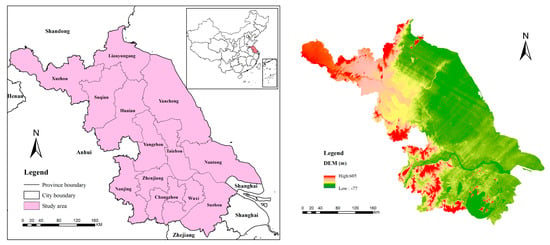
Figure 1.
Location of the study area.
Jiangsu Province is located between approximately 116°18′ to 121°57′ east longitude and 30°45′ to 35°20′ north latitude. It borders the Yellow Sea to the east and is adjacent to Anhui, Shandong, Zhejiang, and Shanghai to the west, north, and southeast, respectively. The province falls within a transitional zone from a temperate to a subtropical climate, with distinct monsoonal climate features. It enjoys abundant light, heat, and water resources; experiences four distinct seasons; and benefits from overall favorable natural conditions.
Jiangsu Province is comprised of 13 prefecture-level cities, including Nanjing (NJ), Wuxi (WX), Changzhou (CZ), Suzhou (SZ), Zhenjiang (ZJ), Nantong (NT), Yangzhou (YZ), Taizhou (TZ), Xuzhou (XZ), Lianyungang (LYG), Huai’an (HA), Yancheng (YC), and Suqian (SQ).
2.2. Data Sources
The land use data for urban areas used in this study were sourced from the China Academy of Sciences Resource and Environment Science and Data Center “http://www.resdc.cn/ (accessed on 16 May 2023)”. These data were captured at a spatial resolution of 30 m × 30 m and were generated from Landsat Thematic Mapper (TM) and Enhanced Thematic Mapper Plus (ETM+) sensors. The interpretation was conducted through human–computer interactive visual interpretation, with an overall accuracy exceeding 88.95%. The primary land use categories used for analysis in this study included cropland, forest, grassland, water bodies, built-up land, and unused land (Figure 2). Digital Elevation Model (DEM) data were obtained from the Geospatial Data Cloud Platform “http://www.gscloud.cn (accessed on 21 June 2023)”. Slope and aspect data were derived from the DEM dataset. The socioeconomic data used in this study were primarily sourced from the China City Statistical Yearbook (2005–2021), the Jiangsu Statistical Yearbook (2005–2021), local statistical yearbooks (2005–2021) from various prefecture-level cities in Jiangsu, the China Urban Construction Statistical Yearbook (2005–2021), and the National Compilation of Agricultural Cost-Benefit Data (2005–2021).
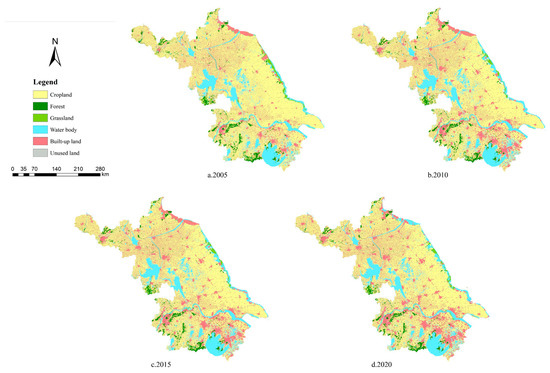
Figure 2.
Distribution of land use type in Jiangsu Province from 2005 to 2020.
2.3. Method
This study developed an indicator system to demonstrate the level of urbanization by gathering socioeconomic data and concurrently calculating the ecosystem service value based on land use data. Then, the above indicators were standardized, and the weight of each indicator was determined using the entropy weight method. Finally, the CCD model was used to clarify the relationship between urbanization and ESV and its subsystems, examine the factors, and provide recommendations. The research framework is illustrated in Figure 3.
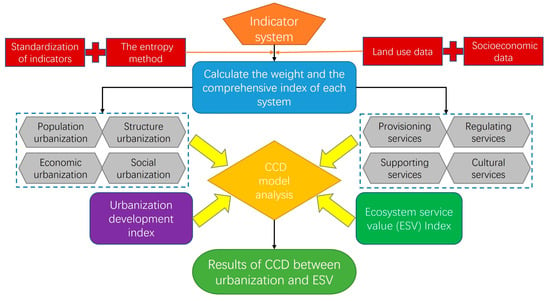
Figure 3.
Research framework for the coupling and coordination relationship between urbanization and ecosystem service value.
2.3.1. Construction of the Indicator System
Urbanization is a comprehensive concept and a systematic process. The urbanization process is generally considered to encompass four main aspects: economic development, population growth, urban spatial expansion, and sociocultural transmission [38]. This article refers to the existing comprehensive evaluation index system [39] and summarizes the connotation of urbanization into the following four aspects: 1. population urbanization mainly reflects the degree of population concentration in cities, which is the basis; 2. Economic urbanization mainly reflects the economic structure and development level; 3. structural urbanization mainly reflects the degree of changes in the geographical landscape of urbanization; and 4. social urbanization mainly reflects the level of lifestyle and infrastructure supporting facilities. These four aspects are intertwined and influence each other, but they comprehensively reflect the level of urbanization from different aspects to varying degrees (Table 1).

Table 1.
Index system of urbanization.
2.3.2. Urbanization Assessment
In this paper, the entropy method was employed to determine the weights of the indicators within the urbanization indicator system. In this method, the weights are calculated based on the information entropy of each indicator. To account for differences in dimensions and quantities of the selected indicators, data normalization is performed before analysis. All indicators are categorized as positive or negative. For positive indicators, higher values correspond to more favorable conditions for urbanization system development (conversely, for negative indicators, larger values indicate less favorable conditions). The following equation is used to transform the indicators into dimensionless values.
Positive indicator: ;
Negative indicator: .
After standardized processing, the numerical range is between 0 and 1. The index weight is determine as follows:
where xij is the ith sample of the jth indicator, and yij is the proportion of xij.
Then, the entropy of each indicator in the urbanization indicator system can be determined as follows:
where ej is the entropy of each indicator, r is the number of samples for each indicator, and t is the number of study years.
The information utility value of index j is calculated as follows:
The weight of each index is calculated as follows:
where m is the number of indicator types.
2.3.3. Estimation of Ecosystem Service Value (ESV)
Costanza [40] was among the first to establish the principles and methods for scientifically estimating ESV and estimated 17 ESV categories for 16 ecosystems globally. Xie Gao Di [41] improved the method of Costanza based on a questionnaire survey of 200 Chinese ecologists. In addition, Xie [42] also formulated the ESV equivalent factor table per unit area of China’s terrestrial ecosystems in 2008 based on the opinions of more than 700 ecologists (Table 2). This factor refers to the potential relative contribution of ecological services produced by different ecosystems. Capacity, the economic value of an equivalent factor, is determined to be 1/7 of the market value of the regional average annual grain production. This study revised the economic value of the ESV equivalent factor per unit area based on the average yield of major grain crops and the average market price of raw grains in Jiangsu Province. The formula is as follows:
where e is the economic value of food service provided by per unit area of farmland (the economic value of an ESV equivalent factor), p is the average crop price, and y is the yield of crop per unit area.

Table 2.
China ecosystem services value equivalent factor table. (Xie et al., 2008) [42].
We used the “Equivalent value per unit area of ESs in China” table (Xie et al., 2008) [42] to obtain the unit area ecosystem equivalent of each city in Jiangsu Province, including food production, raw material production, gas regulation, climate regulation, water resource regulation, waste treatment, soil conservation, biodiversity conservation, and recreation. Since urban construction land does not contribute to ecosystem functions, the equivalent ES value of construction land was set to 0. The ESV per unit area of an ecosystem (E) can be determined as follows:
where e is the economic value of the grain production function of the farmland, and q is the ESV equivalent factor per unit area.
According to the annual land use in Jiangsu Province, the areas of different land use types were calculated. Based on the equivalent ES value per unit area in Jiangsu Province, the calculation formula of the overall ESV is as follows:
where Ai is the area of ecosystem type i, and Eij is the value per unit area of ecosystem service j of ecosystem type i.
2.3.4. Evaluation of Coupling Coordination between Urbanization and Ecosystem Service Value (ESV)
To conduct a more detailed analysis of the relationship between ESV and urbanization, we treated different ecosystem service functions and aspects of urbanization as subsystems of ESV and urbanization, respectively (Table 3). During the urbanization process, factors such as the expansion of built-up land, population density growth, and changes in industrial structure can lead to increased resource consumption, intensified environmental pollution, and greater pressure on ecosystem services. In contrast, the services that ecosystems can provide are limited and act as constraints on urbanization. When the demand for and destruction of ecosystems exceeds a certain threshold, ecosystem services will constrain urbanization.

Table 3.
Criteria for the coupling coordination between urbanization and ESV.
In this paper, the comprehensive assessment values of urbanization and ESV are denoted as U1 and U2, respectively. The CCDM model was employed to reveal the interactive stress relationship between urbanization and ESV. The CCD between urbanization and ecosystem development was calculated at both the system and subsystem levels.
Coupling refers to the phenomenon where two or more systems interact with each other through various interconnections, and the degree of coupling (CD) describes the extent of interactions between systems or elements. The coupling coordination degree (CCD) is an indicator constructed based on the coupling coordination degree, measuring the extent of integrated system development coupling. In the case of k systems, the Coupling Degree Model (CDM) is expressed as follows:
Here, Ui represents the comprehensive value of system i, and C is the CD value for k systems, with values ranging from 0 to 1, reflecting the strength of interactions between systems. A CD of 1 indicates the highest level of coupling, suggesting that the systems and their internal elements are in harmonious resonance, and the overall system structure will develop in a more orderly direction. A CD of 0 indicates the lowest CD, implying that the systems and their internal elements are essentially independent, and the integrated system structure will tend toward disorder.
While CDM can reflect the degree of coupling between systems, it is insufficient when not considering the overall effectiveness and synergy between the two systems. Coordination is a consistent, mutually beneficial relationship within or between systems, ensuring the long-term healthy development of the entire system. Hence, we used the CCDM between urbanization and ESV to determine the coordination within the system, with the formula expressed as follows:
Here, D represents the CCD between U1 and U2; T reflects the overall effects and levels of U1 and U2, with a and b denoting undetermined coefficients and set at 0.5 in this study, as urbanization and ESV are considered equally important. The range of D is from 0 to 1, with higher values indicating greater coherence between subsystems. With reference to previous coupling coordination classification standards, the coupling coordination level was categorized into four stages: low coordination, antagonistic, adaptive, and high coordination.
3. Results
3.1. Urbanization Evaluation
Figure 4 illustrates the urbanization levels in various regions of Jiangsu from 2005 to 2020. Nanjing consistently had the highest urbanization level at all stages, increasing from 0.34 in 2005 to 0.81 in 2020. Conversely, apart from 2005, when Lianyungang had the lowest urbanization level (0.10), Suqian consistently had the lowest urbanization level at all stages, ranging from 0.18 in 2010 to 0.33 in 2020. In 2005, the urbanization levels in different regions of Jiangsu, from high to low with corresponding values, were as follows: Nanjing > Wuxi > Suzhou > Changzhou > Nantong > Zhenjiang > Xuzhou > Yangzhou > Taizhou > Yancheng > Huai’an > Suqian > Lianyungang. In 2020, the order was Nanjing > Suzhou > Wuxi > Changzhou > Nantong > Zhenjiang > Yangzhou > Taizhou > Xuzhou > Yancheng > Huai’an > Lianyungang > Suqian, with corresponding values. This indicates a significant regional disparity in urbanization levels in Jiangsu, with the highest in southern Jiangsu, followed by central Jiangsu, and the lowest in northern Jiangsu.
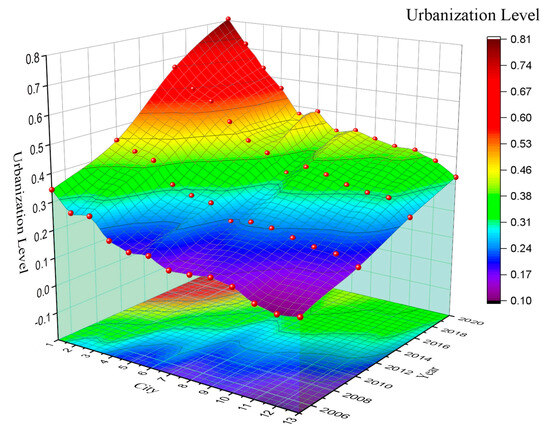
Figure 4.
Three-dimensional urbanization levels of cities. Note: 1. Nanjing; 2. Suzhou; 3. Wuxi; 4. Changzhou; 5. Zhenjiang; 6. Nantong; 7. Taizhou; 8. Yangzhou; 9. Xuzhou; 10. Yancheng; 11. Huai’an; 12. Lianyungang; 13. Suqian.
Regarding the urbanization subsystems (population urbanization, economic urbanization, structural urbanization, social urbanization), Figure 5 shows the differences among various prefecture-level cities in Jiangsu from 2005 to 2020. In 2005, the gap in population urbanization was not significant, with Suzhou ranking second after Changzhou. However, from 2010 to 2020, Suzhou consistently maintained a leading position by a significant margin, reflecting Suzhou’s strong population attraction over the past decade. Economic urbanization saw the greatest growth in Nanjing and the smallest in Lianyungang. Over time, regional disparities became more systematic, showing significant differences among southern Jiangsu, central Jiangsu, and northern Jiangsu in 2020. Structural urbanization had Nanjing far ahead of all other cities at all time stages, with the surprising result of Suzhou ranking last in 2020. This suggests that as large numbers of people have flocked to Suzhou and the economy has rapidly developed, the city’s urban structure urgently needs optimization and evolution. The changes in social urbanization were strongly correlated with economic urbanization, and the patterns were relatively consistent, showing gradual but significant regional differences. The development process of these four urbanization subsystems indicates that urbanization levels in all cities accelerated first and then slowed down. Additionally, economic urbanization and social urbanization saw significant increases from 2010 to 2015.
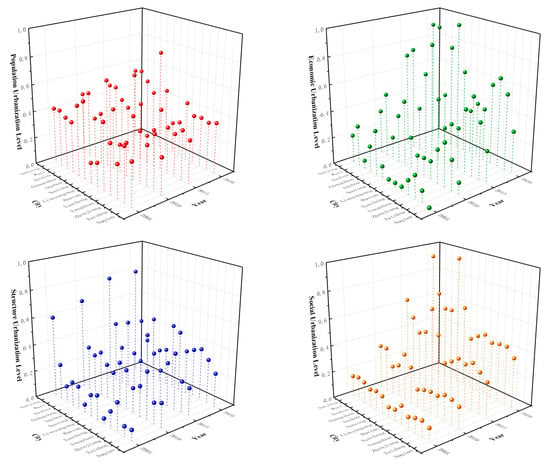
Figure 5.
Levels of different systems of urbanization.
3.2. Estimation of Ecosystem Service Value (ESV)
With the land area of each city in Jiangsu combined, the average ESV per square meter (PESV) was calculated. As shown in Table 4 and Figure 6, Yancheng consistently ranked first in total ESV, except in 2005. However, its PESV did not rank at the top during the different periods. Yancheng, Suzhou, and Huai’an maintained steady positions in the top three for ESVs, significantly exceeding other cities. The ESV of the top-ranking city was approximately four times that of the lowest-ranking city, Zhenjiang. In 2020, the ranking, from highest to lowest, was Suqian > Nantong > Xuzhou > Yangzhou > Nanjing > Lianyungang > Wuxi > Taizhou > Changzhou. Suzhou not only had the highest ESVs but also ranked first in PESV during all periods, with a substantial lead over other cities. Correspondingly, although Xuzhou’s ESV was in the middle range, its PESV ranked at the bottom. In 2020, the ranking was Wuxi > Huai’an > Yangzhou > Changzhou > Suqian > Nanjing > Yancheng > Zhenjiang > Lianyungang > Nantong > Taizhou.

Table 4.
ESV (billion CNY) and PESV (CNY/m2) in Jiangsu from 2005 to 2020.

Figure 6.
ESV and PESV of cities.
Figure 7 displays the changes and change rates of ESV. Overall, ESVs showed a decreasing trend, with PESV following the same pattern. The largest increase in ESV from 2005 to 2010 was in Yancheng, amounting to CNY 28.80 billion, while Xuzhou saw the most significant decrease, with a reduction of CNY 10.65 billion. Apart from Nantong and Taizhou, which experienced slight growth, all other cities witnessed varying degrees of decline. From 2010 to 2015, the ESV decreased across the province, with Nantong experiencing the most substantial decline of CNY 8.55 billion. In the period from 2015 to 2020, Lianyungang and Yancheng showed the most considerable growth, amounting to CNY 14.38 billion and CNY 40.06 billion, respectively. Suzhou and Nantong experienced the most significant declines, with reductions of CNY 14.29 billion and CNY 17.10 billion, respectively. Over the entire period from 2005 to 2020, Yancheng and Lianyungang increased their ESV by CNY 40.06 billion and CNY 14.38 billion, respectively. The three cities with the most substantial reductions were Nantong, Suzhou, and Xuzhou, with decreases of CNY 17.10 billion, CNY 14.29 billion, and CNY 13.18 billion, respectively.
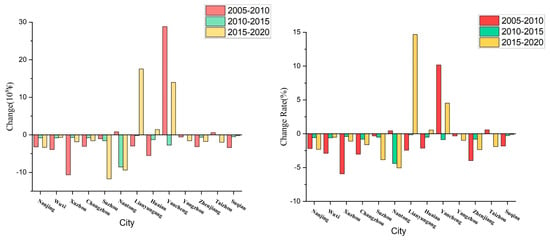
Figure 7.
ESV changes and ESV change rates of cities.
Figure 8 presents the change rates of ESV functions as a proportion of total ESV from 2005 to 2020. The proportions of WR and WT increased in the entire province, with the most significant changes seen in Yancheng and Lianyungang, where WR rates reached 5.16% and 2.89%, respectively, and WT change reached 2.59% and 1.69%, respectively. This is primarily due to the abundant water resources in Jiangsu and recent efforts in environmental conservation, particularly water resource management. The most significant factors influencing WR and WT are water resources, indirectly leading to an increase in ET throughout the province. For the remaining ESV functions, they decreased to varying degrees except for minor increases in some areas. Yancheng and Lianyungang also dominated the list for the most significant decreases, indicating the least stable ecosystem structure in these two cities.
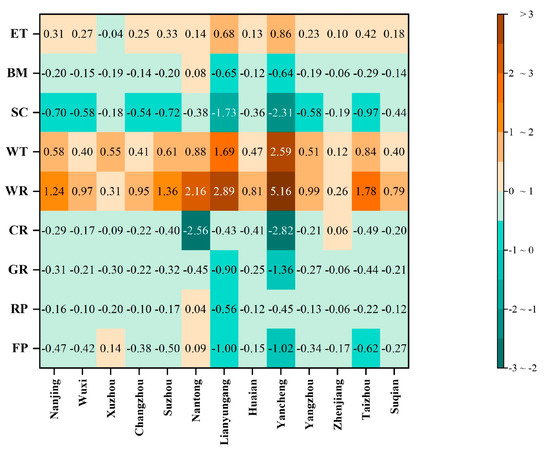
Figure 8.
The change rates of ESV functions as a proportion of total ESV from 2005 to 2020.
3.3. The CCD between Urbanization and Ecosystem Service Value (ESV)
3.3.1. The Overall Interactive Coupling Relationship
Figure 9 displays the changes in C values and D values for cities in Jiangsu Province. Zhenjiang had the lowest C values and D values, indicating the weakest correlation and coordination between urbanization and ESV. This trend also exhibited a clear decreasing pattern, with both C and D levels reaching the second lowest classification of c and E in 2020. Changzhou, Taizhou, Wuxi, and Nanjing showed significant declines in C values, with the first three cities experiencing notable downgrading. Other cities had good C values, with slight fluctuations but generally above 0.8, categorizing them as “a” level, indicating strong coupling. Except for Zhenjiang, the D values across the entire province generally rose, indicating increasing coordination between urbanization levels and ESV in different cities. However, this coordination has not reached the ideal level. Most cities fell into the categories of “Basic coordination” and “Positive coordination”, with none reaching “High coordination”. Figure 10 demonstrates the spatial distribution of CCD levels among cities in Jiangsu Province. Suzhou and Zhenjiang maintained their respective CCD levels, at B and E, with Lianyungang showing the most significant change, rising by two levels from E to C. The overall level change was most significant between 2010 and 2015.
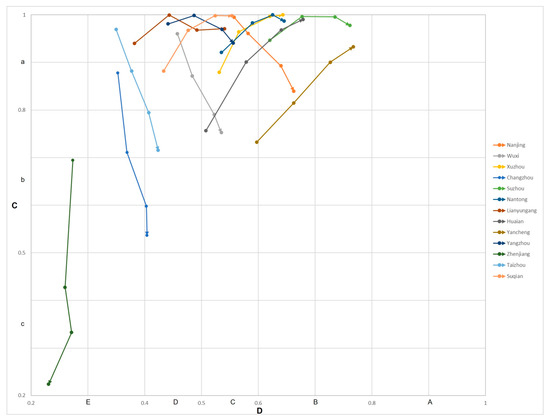
Figure 9.
The changes in C values and D values of cities from 2005 to 2020.
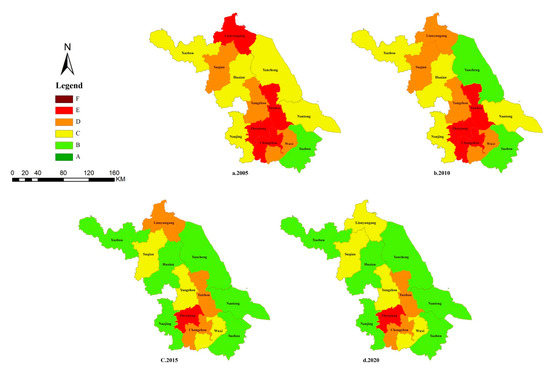
Figure 10.
The CCD between urbanization and ESV and the comparison of their levels.
3.3.2. The CCD between ESV and Subsystems of Urbanization
Figure 11 shows the CCD results between ESV and subsystems of urbanization. In 2015 and 2020, Suzhou had CCD levels for economic urbanization and social urbanization exceeding 0.8, classifying them as “High coordination”, which was higher than that of other cities. Additionally, in 2015 and 2020, Changzhou, Lianyungang, Zhenjiang, and Taizhou had CCD values below 0.5 for population urbanization and economic urbanization, indicating a lack of coordination and unclear changes, with Zhenjiang having the lowest levels of “Middle incoordination” for both population and economic urbanization.
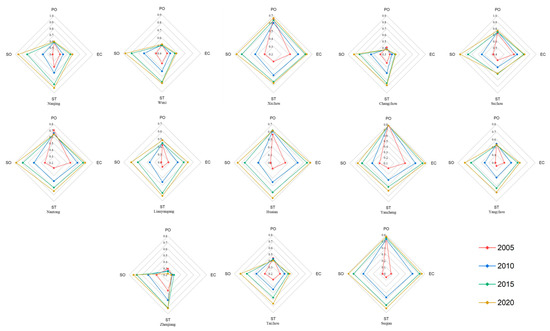
Figure 11.
The CCD of ESV and different urbanization systems.
Regarding the development history of each city, the CCD for population urbanization exhibited the smallest changes and lacked a discernible pattern. Economic urbanization, structural urbanization, and social urbanization CCDs all showed an overall upward trend, but the magnitude and direction of change varied. The most significant change was observed in social urbanization, followed by structural urbanization. The social urbanization CCD in all cities shifted from overall incoordination in 2005 to overall coordination in 2020, with Suzhou, Wuxi, Nanjing, and Changzhou in the southern part of Jiangsu achieving “High coordination”.
3.3.3. The CCD between Urbanization and Subsystems of ESV
Figure 12 presents the CCDs between urbanization and ecosystem service functions. In 2020, Yancheng showed all values above 0.7, representing “Positive coordination” and the highest and most balanced comprehensive level. Additionally, Suzhou had higher CCD values for hydrological regulation, waste disposal, and recreation with urbanization compared to other cities, classifying them as “High coordination”. Conversely, Zhenjiang had the lowest comprehensive level, and Wuxi’s food production, Taizhou’s raw material production, and Changzhou’s gas regulation CCD with urbanization lagged.
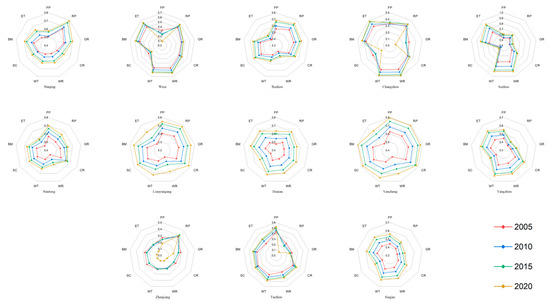
Figure 12.
The CCD of urbanization and different ecosystem service functions.
Between 2005 and 2020, most cities experienced increased CCDs in various systems, but some cities such as Wuxi, Changzhou, and Taizhou had declining trends with urbanization in food production, gas regulation, and raw material production, respectively. Water regulation, waste disposal, and recreation showed the most significant changes in CCDs throughout the province, while gas regulation, soil preservation, and food production had smaller fluctuations. In 2005, only Nanjing achieved coordination in all functions with urbanization, with the remaining cities displaying varying degrees of incoordination. By 2020, Nanjing, Suzhou, Nantong, Huai’an, and Yancheng reached varying levels of coordination between all functions and urbanization. Nevertheless, Zhenjiang, Changzhou, and Taizhou still had most functions in incoordination with urbanization.
4. Discussion
4.1. The Mutual Restriction between Urbanization and ESV
Urbanization is an inevitable product of rapid socioeconomic development, and urban expansion is a critical driver of this process [43]. However, urban expansion also leads to a range of ecological issues, and the degradation of the ecological environment can, in turn, hamper the progress of urbanization. Jiangsu Province, a major province for urbanization development in China, provides insights into the relationship between urbanization and ESV from 2005 to 2020. The results show that urbanization levels have continued to rise but with significant differences in the speed and level of urbanization among different cities. There is a distinct division between northern, central, and southern regions, consistent with previous research results [44], which is gradually intensifying. The subsystems of urbanization have experienced unbalanced development, with economic urbanization playing a significant role. Given that China’s demographic dividend is gradually diminishing [45], population urbanization is expected to have a more significant impact on the urbanization process. Abundant global research shows that the rapid development of urbanization has resulted in substantial losses in ESV [46,47,48]. Rapid urbanization has led to a substantial increase in land used for construction, particularly at the cost of ecologically functional land, especially high-quality arable land [49]. This poses a severe threat to food and ecological security in the region. While Yancheng and Lianyungang have shown an increase in ESV, further analysis reveals an increase in water regulation (WR), water supply (WT), and evapotranspiration (ET). This is due to the series of ecological restoration measures in the coastal regions, such as returning farmland to wetlands and lakes. Nonetheless, urbanization processes have still significantly reduced other functions of ESV. Other cities have witnessed increases in WR, WT, and ET values due to adjustments in industrial structure, an increase in aquaculture areas, and the density of artificial canals. While these adjustments link various ecosystem types and promote the flow of information, materials, and energy between patches, they tend to make the structure of ecosystem functions more homogeneous and increase ecological vulnerability [50], which is a cause for concern.
4.2. Coupling Coordination of Urbanization and ESV
As mentioned earlier, urbanization and ESV are interrelated with mutual restrictions and interactions. To better understand the extent and characteristics of their mutual impact, the study examined their coupling coordination, which is crucial for the healthy development of regional cities [51]. The results show that most cities have a high coupling degree, indicating a strong association between urbanization and ESV. Moreover, the D values are generally on the rise, and many have reached a level of coordination. This is largely due to the increased emphasis on ecological protection by the government, as they respond actively to national policies. However, the intrinsic relationship between urbanization and ESV has not been optimized and highlights some serious issues. The relationship between urbanization subsystems and ESV is imbalanced, with some cities showing imbalances and degradation in the coupling coordination of population urbanization and ESV, especially in terms of economic urbanization. This suggests that population mobility within Jiangsu Province is high, with people primarily moving to economically prosperous cities, resulting in population-outflow cities having economic urbanization-ESV CCDs that lag behind the CCDs for structural and social urbanization. The relationship between ESV subsystems and urbanization is also not very stable. In Wuxi and Changzhou, the coupling coordination between food production and soil regulation with urbanization has deteriorated, indicating a growing conflict between the conversion of high-quality farmland and the protection of ecological environments [52]. Urban expansion consumes a substantial amount of ecologically functional land, particularly around urban perimeters and high-quality arable land. Despite land use policies, such as cultivated land protection designed to slow the overall reduction of arable land [53], these policies have resulted in both arable land being pushed onto hills and wetlands and in the fragmentation of various ecologically functional lands. This has led to varying degrees of ecosystem function damage, and although recent years have seen significant improvements in ecological environment restoration, many of these measures prioritize creating wetland parks and aquaculture, which, while providing short-term benefits, exacerbate food security and ecological system homogenization. Furthermore, the extensive use of pesticides and fertilizers, industrial emissions of air and water pollutants, and the accumulation of domestic waste due to population aggregation have caused severe air, water, and soil pollution. This has also threatened ecosystem service functions, such as atmospheric regulation, hydrological regulation, waste disposal, and soil conservation [54], as their coupling coordination with urbanization has not been sufficiently strong. Hence, comprehensive protection of ecosystems is necessary to maintain various ecosystem service functions during urbanization.
4.3. Implications and Limitations
Guiding urbanization towards a focus on improving quality rather than speed is crucial [55]. As land resources become scarcer with urbanization, the past development model, primarily focused on economic growth, is unsustainable. Government decision-makers should optimize land use structures, implement city planning boundaries, balance urban development with ecological protection, and promote the rational development of natural resources. Achieving sustainable land use is also crucial for addressing food security and ecological safety. The transformation of land use is influenced by economic measures, land engineering, policies, and institutional aspects of land management [56,57]. Considering the difference of urbanization level and ecosystem service value, this paper also puts forward some effective policy suggestions: For urbanization, achieving high-quality population urbanization promotes attracting and retaining talent. The economic side should prioritize technological innovation, industrial upgrading, and a shift away from labor-intensive industries, aiming for a “green economy” under the dual carbon goals. For urban structure, the government needs proper control of large city scales and rational city boundary definition. Social urbanization should involve improved social welfare benefits, increased investment in science and education, and leadership in information society development. Regarding ESV, decision-makers need to strengthen ecological protection when formulating land use policies in the future. They should also pay attention to protecting the diversity of ecosystem functions and avoid overly emphasizing the enhancement of certain high-ESV factors (such as water bodies and wetlands) to offset ESV losses during the urbanization process, which could lead to structural imbalances in ecosystems. Although most cities in Jiangsu Province have a high coordination level of urbanization and ESV, urbanization scales are also constrained by the ecological environment’s carrying capacity [58]. As new land spatial planning work is underway, the focus should shift away from an economic-centric mindset. Instead, a more comprehensive approach to ecological effect analysis is recommended. ESV should be used as a quantitative indicator for measuring ecological effects, which is vital for the scientific validity, rationality, and completeness of ecological planning.
This study still has room for improvement. Although the urbanization indicator system was constructed based on the work of numerous researchers, limitations stemming from statistical data constraints still exist. Data selection and prioritization have resulted in an indicator system that does not comprehensively reflect the actual progress of urbanization in different cities and only accounts for differences in time dimensions. There is less research into spatial dimensions. Similarly, calculations for ESV have their limitations. While this study adjusted value coefficients to align with local characteristics, this approach may also be suitable for research in other parts of the world. However, more exploration is needed into the characteristics of ecosystem functionality, supply and demand, and human impacts on these systems. Future work should involve on-site data collection to analyze urban spatial response trends, enhance the depth of the urbanization indicator system, and develop a more comprehensive and improved ESV model that includes a wider range of ecosystem characteristics, providing a more comprehensive analysis of the synergistic relationship between urbanization and ESV.
5. Conclusions
This study, through the construction of an urbanization indicator system and the estimation of ecosystem service values, has provided a systematic and subsystem-level investigation into the coupling coordination between urbanization and ecosystem service value. The findings suggest the following:
Urbanization levels in Jiangsu Province have seen a gradual increase from 2005 to 2020, with a typical regional difference: urbanization decreases gradually from south to north. The overall ESV demonstrates a decreasing trend, and the cities in the southern part of Jiangsu, with rapid urbanization, have experienced substantial reductions in ESV. This supports the notion that urbanization has a negative impact on ESV.
From 2005 to 2020, the ESV in Jiangsu Province showed some degradation, although it was not severe. However, attempts to mitigate this degradation by increasing water bodies pose substantial risks.
Most cities in Jiangsu Province exhibit a high level of coupling between urbanization and ESV, with an upward trend in coordination. However, the overall coordination is not yet ideal. Some subsystems’ coupling coordination with ESV shows signs of degradation, particularly in terms of population urbanization and economic urbanization.
Jiangsu Province is known for its rapid economic development and is facing growing challenges to ecological sustainability. This study’s exploratory work is not only of paramount importance for regional sustainable development but also provides valuable insights for the ongoing transformation and upgrading of Jiangsu Province.
Author Contributions
Conceptualization, Z.C.; methodology, Z.C. and J.C.; software, Z.C.; validation, Z.C.; formal analysis, Z.C. and W.H.; investigation, Z.C.; resources, Z.C.; data curation, Z.C.; writing—original draft preparation, Z.C.; writing—review and editing, Z.C., W.H., J.C. and H.J.; visualization, X.L.; supervision, X.L.; project administration, X.L.; funding acquisition, X.L. All authors have read and agreed to the published version of the manuscript.
Funding
This research was funded by the National Natural Science Foundation Program (grant no. 71874192) and the Major Project of Philosophy and Social Science Research in Colleges and Universities of Jiangsu Province (grant no. 23WTA-001).
Data Availability Statement
Data is contained within the article.
Conflicts of Interest
The authors declare no conflicts of interest.
References
- Daily, G.C. Nature’s Services: Societal Dependence on Natural Ecosystems; Island Press: Washington, DC, USA, 1997. [Google Scholar]
- Fisher, B.; Turner, R.K.; Morling, P. Defining and classifying ecosystem services for decision making. Ecol. Econ. 2009, 68, 643–653. [Google Scholar] [CrossRef]
- Costanza, R.; d’Arge, R.; de Groot, R.; Farber, S.; Grasso, M.; Hannon, B.; Limburg, K.; Naeem, S.; O’Neill, R.V.; Paruelo, J.; et al. The value of the world’s ecosystem services and natural capital. Nature 1997, 387, 253–260. [Google Scholar] [CrossRef]
- Vallecillo, S.; Kakoulaki, G.; La Notte, A.; Feyen, L.; Dottori, F.; Maes, J. Accounting for changes in flood control delivered by ecosystems at the EU level. Ecosyst. Serv. 2020, 44, 101142. [Google Scholar] [CrossRef]
- Leroy, G.; Baumung, R.; Boettcher, P.; Besbes, B.; From, T.; Hoffmann, I. Animal genetic resources diversity and ecosystem services. Glob. Food Secur.-Agric. Policy Econ. Environ. 2018, 17, 84–91. [Google Scholar] [CrossRef]
- Allsopp, M.H.; de Lange, W.J.; Veldtman, R. Valuing Insect Pollination Services with Cost of Replacement. PLoS ONE 2008, 3, e3128. [Google Scholar] [CrossRef]
- Costanza, R.; de Groot, R.; Sutton, P.; van der Ploeg, S.; Anderson, S.J.; Kubiszewski, I.; Farber, S.; Turner, R.K. Changes in the global value of ecosystem services. Glob. Environ. Chang. 2014, 26, 152–158. [Google Scholar] [CrossRef]
- Girardello, M.; Santangeli, A.; Mori, E.; Chapman, A.; Fattorini, S.; Naidoo, R.; Bertolino, S.; Svenning, J.-C. Global synergies and trade-offs between multiple dimensions of biodiversity and ecosystem services. Sci. Rep. 2019, 9, 5636. [Google Scholar] [CrossRef]
- Manoli, G.; Fatichi, S.; Schlapfer, M.; Yu, K.; Crowther, T.W.; Meili, N.; Burlando, P.; Katul, G.G.; Bou-Zeid, E. Magnitude of urban heat islands largely explained by climate and population. Nature 2019, 573, 55–60. [Google Scholar] [CrossRef] [PubMed]
- Maron, M.; Simmonds, J.S.; Watson, J.E.M.; Sonter, L.J.; Bennun, L.; Griffiths, V.F.; Quetier, F.; von Hase, A.; Edwards, S.; Rainey, H.; et al. Global no net loss of natural ecosystems. Nat. Ecol. Evol. 2020, 4, 46–49. [Google Scholar] [CrossRef] [PubMed]
- Steffen, W.; Crutzen, P.J.; McNeill, J.R. The Anthropocene: Are humans now overwhelming the great forces of nature. Ambio 2007, 36, 614–621. [Google Scholar] [CrossRef] [PubMed]
- Wiedmann, T.; Lenzen, M.; Keysser, L.T.; Steinberger, J.K. Scientists’ warning on affluence. Nat. Commun. 2020, 11, 3107. [Google Scholar] [CrossRef]
- Nations, U. Revision of World Urbanization Prospects; United Nations: New York, NY, USA, 2018; p. 799. [Google Scholar]
- Yang, W.; Jin, Y.; Sun, T.; Yang, Z.; Cai, Y.; Yi, Y. Trade-offs among ecosystem services in coastal wetlands under the effects of reclamation activities. Ecol. Indic. 2018, 92, 354–366. [Google Scholar] [CrossRef]
- Delphin, S.; Escobedo, F.J.; Abd-Elrahman, A.; Cropper, W.P. Urbanization as a land use change driver of forest ecosystem services. Land Use Policy 2016, 54, 188–199. [Google Scholar] [CrossRef]
- Duraiappah, A.K.; Naeem, S.; Agardy, T.; Ash, N.J.; Cooper, D.; Díaz, S.; Faith, D.P.; Mace, G.; McNeely, J.A.; Mooney, H.A. Ecosystems and Human Well-Being: Biodiversity Synthesis. 2005. Available online: http://opus.sanbi.org/handle/20.500.12143/8626 (accessed on 18 June 2023).
- Liu, J.; Li, J.; Qin, K.; Zhou, Z.; Yang, X.; Li, T. Changes in land-uses and ecosystem services under multi-scenarios simulation. Sci. Total Environ. 2017, 586, 522–526. [Google Scholar] [CrossRef] [PubMed]
- Seto, K.C.; Parnell, S.; Elmqvist, T. A Global Outlook on Urbanization. Urbanization, Biodiversity and Ecosystem Services: Challenges and Opportunities: A Global Assessment; Springer: New York, NY, USA, 2013; pp. 1–12. [Google Scholar]
- Fei, W.; Zhao, S. Urban land expansion in China’s six megacities from 1978 to 2015. Sci. Total Environ. 2019, 664, 60–71. [Google Scholar] [CrossRef]
- Grimm, N.B.; Faeth, S.H.; Golubiewski, N.E.; Redman, C.L.; Wu, J.; Bai, X.; Briggs, J.M. Global change and the ecology of cities. Science 2008, 319, 756–760. [Google Scholar] [CrossRef] [PubMed]
- Admasu, W.F.; Boerema, A.; Nyssen, J.; Minale, A.S.; Tsegaye, E.A.; Van Passel, S. Uncovering Ecosystem Services of Expropriated Land: The Case of Urban Expansion in Bahir Dar, Northwest Ethiopia. Land 2020, 9, 395. [Google Scholar] [CrossRef]
- Newbold, T.; Hudson, L.N.; Arnell, A.P.; Contu, S.; De Palma, A.; Ferrier, S.; Hill, S.L.L.; Hoskins, A.J.; Lysenko, I.; Phillips, H.R.P.; et al. Has land use pushed terrestrial biodiversity beyond the planetary boundary? A global assessment. Science 2016, 353, 288–291. [Google Scholar] [CrossRef]
- Yuan, Y.; Wu, S.; Yu, Y.; Tong, G.; Mo, L.; Yan, D.; Li, F. Spatiotemporal interaction between ecosystem services and urbanization: Case study of Nanjing City, China. Ecol. Indic. 2018, 95, 917–929. [Google Scholar] [CrossRef]
- Brunner, J.; Cozens, P. ‘Where have all the trees gone?’ Urban consolidation and the demise of urban vegetation: A case study from Western Australia. Plan. Pract. Res. 2013, 28, 231–255. [Google Scholar] [CrossRef]
- Plieninger, T.; Dijks, S.; Oteros-Rozas, E.; Bieling, C. Assessing, mapping, and quantifying cultural ecosystem services at community level. Land Use Policy 2013, 33, 118–129. [Google Scholar] [CrossRef]
- Willemen, L.; Hein, L.; van Mensvoort, M.E.F.; Verburg, P.H. Space for people, plants, and livestock? Quantifying interactions among multiple landscape functions in a Dutch rural region. Ecol. Indic. 2010, 10, 62–73. [Google Scholar] [CrossRef]
- Elliot, T.; Goldstein, B.; Gomez-Baggethun, E.; Proenca, V.; Rugani, B. Ecosystem service deficits of European cities. Sci. Total Environ. 2022, 837, 155875. [Google Scholar] [CrossRef]
- De Vreesea, R.; Leys, M.; Fontaine, C.M.; Dendoncker, N. Social mapping of perceived ecosystem services supply—The role of social landscape metrics and social hotspots for integrated ecosystem services assessment, landscape planning and management. Ecol. Indic. 2016, 66, 517–533. [Google Scholar] [CrossRef]
- Yi, H.; Guneralp, B.; Kreuter, U.P.; Guneralp, I.; Filippi, A.M. Spatial and temporal changes in biodiversity and ecosystem services in the San Antonio River Basin, Texas, from 1984 to 2010. Sci. Total Environ. 2018, 619, 1259–1271. [Google Scholar] [CrossRef] [PubMed]
- La Notte, A.; Vallecillo, S.; Maes, J. Capacity as “virtual stock” in ecosystem services accounting. Ecol. Indic. 2019, 98, 158–163. [Google Scholar] [CrossRef] [PubMed]
- Vaz, A.S.; Amorim, F.; Pereira, P.; Antunes, S.; Rebelo, H.; Oliveira, N.G. Integrating conservation targets and ecosystem services in landscape spatial planning from Portugal. Landsc. Urban Plan. 2021, 215, 104213. [Google Scholar] [CrossRef]
- Aziz, T.; Van Cappellen, P. Comparative valuation of potential and realized ecosystem services in Southern Ontario, Canada. Environ. Sci. Policy 2019, 100, 105–112. [Google Scholar] [CrossRef]
- Castro, A.J.; Verburg, P.H.; Martin-Lopez, B.; Garcia-Llorente, M.; Cabello, J.; Vaughn, C.C.; Lopez, E. Ecosystem service trade-offs from supply to social demand: A landscape-scale spatial analysis. Landsc. Urban Plan. 2014, 132, 102–110. [Google Scholar] [CrossRef]
- Lu, X.; Shi, Y.; Chen, C.; Yu, M. Monitoring cropland transition and its impact on ecosystem services value in developed regions of China: A case study of Jiangsu Province. Land Use Policy 2017, 69, 25–40. [Google Scholar] [CrossRef]
- Li, Y.; Shi, Y.; Zhu, X.; Cao, H.; Yu, T. Coastal wetland loss and environmental change due to rapid urban expansion in Lianyungang, Jiangsu, China. Reg. Environ. Chang. 2014, 14, 1175–1188. [Google Scholar] [CrossRef]
- Fang, G.; Yuan, T.; Zhang, Y.; Wen, X.; Lin, R. Integrated study on soil erosion using RUSLE and GIS in Yangtze River Basin of Jiangsu Province (China). Arab. J. Geosci. 2019, 12, 173. [Google Scholar] [CrossRef]
- Cao, X.; Huang, X.; Huang, H.; Liu, J.; Guo, X.; Wang, W.; She, D. Changes and driving mechanism of water footprint scarcity in crop production: A study of Jiangsu Province, China. Ecol. Indic. 2018, 95, 444–454. [Google Scholar] [CrossRef]
- Guo, X.; Fang, C.; Mu, X.; Chen, D. Coupling and coordination analysis of urbanization and ecosystem service value in Beijing-Tianjin-Hebei urban agglomeration. Ecol. Indic. 2022, 137, 108782. [Google Scholar] [CrossRef]
- Xiao, R.; Lin, M.; Fei, X.; Li, Y.; Zhang, Z.; Meng, Q. Exploring the interactive coercing relationship between urbanization and ecosystem service value in the Shanghai–Hangzhou Bay Metropolitan Region. J. Clean. Prod. 2020, 253, 119803. [Google Scholar] [CrossRef]
- Costanza, R.; de Groot, R.; Farber, S.; Grasso, M.; Hannon, B.; Limburg, K.; Naeem, S.; Paruelo, J.; Raskin, R.; Sutton, P. The value of the world’s ecosystem services and natural capital. Ecol. Econ. 1998, 25, 3–15. [Google Scholar] [CrossRef]
- Xie, G.-D.; Lu, C.X.; Leng, Y.-F.; Zheng, D.; Li, S. Ecological assets valuation of the Tibetan Plateau. J. Nat. Resour. 2003, 18, 189–196. [Google Scholar]
- Xie, G.; Zhen, L.; Lu, C.-X.; Xiao, Y.; Chen, C. Expert knowledge based valuation method of ecosystem services in China. J. Nat. Resour. 2008, 23, 911–919. [Google Scholar]
- Chen, W.; Wang, G.; Zeng, J. Impact of urban expansion on ecosystem services in different urban agglomerations in China. Int. J. Environ. Sci. Technol. 2023, 20, 12625–12644. [Google Scholar] [CrossRef]
- He, W.K.; Li, X.S.; Yang, J.; Ni, H.; Sang, X.J. How land use functions evolve in the process of rapid urbanization: Evidence from Jiangsu Province, China. J. Clean. Prod. 2022, 380, 11. [Google Scholar] [CrossRef]
- Cai, F. The Second Demographic Dividend as a Driver of China’s Growth. China World Econ. 2020, 28, 26–44. [Google Scholar] [CrossRef]
- Shrestha, M.; Acharya, S.C. Assessment of historical and future land-use-land-cover changes and their impact on valuation of ecosystem services in Kathmandu Valley, Nepal. Land Degrad. Dev. 2021, 32, 3731–3742. [Google Scholar] [CrossRef]
- Degefu, M.A.; Argaw, M.; Feyisa, G.L.; Degefa, S. Dynamics of urban landscape nexus spatial dependence of ecosystem services in rapid agglomerate cities of Ethiopia. Sci. Total Environ. 2021, 798, 22. [Google Scholar] [CrossRef] [PubMed]
- Yang, L.; Zhang, S.; Yin, L.; Zhang, B. Global occupation of wetland by artificial impervious surface area expansion and its impact on ecosystem service value for 2001–2018. Ecol. Indic. 2022, 142, 109307. [Google Scholar] [CrossRef]
- Deng, X.Z.; Huang, J.K.; Rozelle, S.; Zhang, J.P.; Li, Z.H. Impact of urbanization on cultivated land changes in China. Land Use Policy 2015, 45, 1–7. [Google Scholar] [CrossRef]
- Felipe-Lucia, M.R.; Soliveres, S.; Penone, C.; Fischer, M.; Ammer, C.; Boch, S.; Boeddinghaus, R.S.; Bonkowski, M.; Buscot, F.; Fiore-Donno, A.M.; et al. Land-use intensity alters networks between biodiversity, ecosystem functions, and services. Proc. Natl. Acad. Sci. USA 2020, 117, 28140–28149. [Google Scholar] [CrossRef] [PubMed]
- Yu, Q.; Feng, C.-C.; Shi, Y.; Guo, L. Spatiotemporal interaction between ecosystem services and urbanization in China: Incorporating the scarcity effects. J. Clean. Prod. 2021, 317, 128392. [Google Scholar] [CrossRef]
- Li, Z.T.; Li, M.; Xia, B.C. Spatio-temporal dynamics of ecological security pattern of the Pearl River Delta urban agglomeration based on LUCC simulation. Ecol. Indic. 2020, 114, 106319. [Google Scholar] [CrossRef]
- Wu, S.Z.; Wang, D.Y. Storing Grain in the Land: The Gestation, Delineation Framework, and Case of the Two Zones Policy in China. Land 2023, 12, 806. [Google Scholar] [CrossRef]
- Qi, Y.; Lian, X.H.; Wang, H.W.; Zhang, J.L.; Yang, R. Dynamic mechanism between human activities and ecosystem services: A case study of Qinghai lake watershed, China. Ecol. Indic. 2020, 117, 106528. [Google Scholar] [CrossRef]
- Bai, Y.; Deng, X.; Jiang, S.; Zhang, Q.; Wang, Z. Exploring the relationship between urbanization and urban eco-efficiency: Evidence from prefecture-level cities in China. J. Clean. Prod. 2018, 195, 1487–1496. [Google Scholar] [CrossRef]
- Lambin, E.F.; Meyfroidt, P. Land use transitions: Socio-ecological feedback versus socio-economic change. Land Use Policy 2010, 27, 108–118. [Google Scholar] [CrossRef]
- Long, H.; Qu, Y. Land use transitions and land management: A mutual feedback perspective. Land Use Policy 2018, 74, 111–120. [Google Scholar] [CrossRef]
- Lu, D.; Chen, M. Several viewpoints on the background of compiling the “National New Urbanization Planning (2014–2020)”. Acta Geogr. Sin. 2015, 70, 179–185. [Google Scholar]
Disclaimer/Publisher’s Note: The statements, opinions and data contained in all publications are solely those of the individual author(s) and contributor(s) and not of MDPI and/or the editor(s). MDPI and/or the editor(s) disclaim responsibility for any injury to people or property resulting from any ideas, methods, instructions or products referred to in the content. |
© 2024 by the authors. Licensee MDPI, Basel, Switzerland. This article is an open access article distributed under the terms and conditions of the Creative Commons Attribution (CC BY) license (https://creativecommons.org/licenses/by/4.0/).